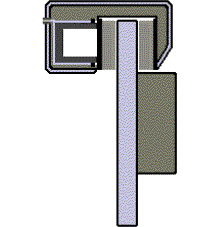Disc Brake
| Disc brakes almost only advantages (except hand brake effectiveness) |
The disc brake, as a large series product, was introduced in the USA before the middle of the last century, in Europe thereafter. It can counteract a failure of the brakes by overheating (fading) especially well. At the front
axle it avoids pulling. The removal of brake lining dust improves and the assembly is clearly simpler. Also the braking power differences of some drum brakes comparing forward and backward driving, are history.
| Cast iron disc with sliding- or fixed caliper (upper class) |
While braking, the coatings are pressed from the inside and outside onto a disc linked with the wheel mostly from grey iron, nodular graphite iron, steel or less
often coal fibre materials. Because the caliper mechanism is connected to the wheel suspension, the brake disc and with it the wheel, is slowed down.
 Once in a blue moon you might come across a driven
axle with disc brake positioned inside at the final drive. Brake tongs solidly linked with the suspension are called fixed caliper (figures on top). Here pistons operate from both sides on the disc / lining. If it is movable,
one speaks of a sliding caliper (figure on the left). Older types are also called floating caliper. Here one or two pistons operate exclusively from the inside. Once in a blue moon you might come across a driven
axle with disc brake positioned inside at the final drive. Brake tongs solidly linked with the suspension are called fixed caliper (figures on top). Here pistons operate from both sides on the disc / lining. If it is movable,
one speaks of a sliding caliper (figure on the left). Older types are also called floating caliper. Here one or two pistons operate exclusively from the inside.
| Pneumatically-operated disc brakes hot |
The operation of the hand brake usually takes place via cables and levers at the wheel brake, the hydraulical foot brake makes use of brake fluid pressure
onto one or more pistons and cylinders and in case of the pneumatically-operated brake via external diaphragm- or
(again less often) piston cylinders. In case of air pressure as well as hydraulics, brake tongs reaching from the inside around the brake disc are possible to increase the friction area. The disc brake does not have
self-reinforcing powers. Therefore, e.g., the pistons and with it the operating forces are higher. Heat and dust can be led away quite well due to the open arrangement. Internal ventilation and outside ventilation of the
brake disc (figures 1 and 3) may increase this effect.
| Only very small motorcycles do not feature disc brakes. |
Almost all motorcycles feature discbrakes. Passenger cars have them at least in front, most often also in the rear. Just smaller, low weight cars have drum brakes in the rear.The distribution of pneumatically-operated disc brakes is clearly increasing for busses and trucks. Also modern and fast track-vehicles feature
this technique. 02/09
| Disc brake noise measurement with laser technology |
|